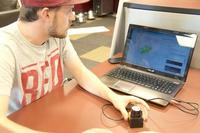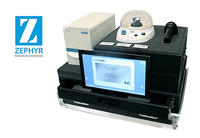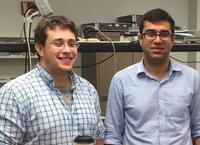-
Room-scouting robot to help first responders, soldiers

Firefighters, police officers, and military personnel are often required to enter rooms with little information about what dangers might lie behind the door. A group of engineering students at Arizona State University is working on a project which would help alleviate that uncertainty. The product they are building consists of a laser sensor attached to a motor that sweeps all the way around a room, taking 700-800 individual scans, each one with about 680 unique data points. This information is transmitted to a computer program that creates a picture of the room and all its contents. Whoever is controlling the sensor remotely can see and analyze the data in real-time, as it is being collected.
-
-
PathSensors introduces portable pathogen identifier system

Baltimore, Maryland-based PathSensors, Inc. has introduced the portable Zephyr Pathogen Identifier system. The company says it delivers rapid, reliable detection of bacteria, virus, and toxins in powder and liquid samples in minutes. The Zephyr Identifier uses CANARY (Cellular Analysis and Notification of Antigen Risks and Yields) technology, which is licensed from the MIT-Lincoln Laboratory.
-
-
Detecting and defeating radiological threats
Brookhaven National Laboratory’s Radiological Assistance Program (RAP) team works to stay ahead of any radiological threats by using many detection tools that have become increasingly sophisticated and user-friendly. During a deployment, researchers and technicians with backgrounds in various aspects of radiological controls and analysis conduct field monitoring and environmental sampling, assessment, and documentation activities to help decision makers choose appropriate protective actions for the safety of both the public and first responders.
-
-
“Dressed” laser aims at clouds to induce rain, lightning

The adage “Everyone complains about the weather but nobody does anything about it,” may one day be obsolete if researchers further develop a new technique to aim a high-energy laser beam into clouds to make it rain or trigger lightning. The researchers work on surround the beam with a second beam to act as an energy reservoir, sustaining the central beam to greater distances than previously possible. The secondary “dress” beam refuels and helps prevent the dissipation of the high-intensity primary beam. Gaining control over the length of a filament would allow the creation of the conditions needed for a rainstorm from afar. People could thus artificially control the rain and lightning over a large expanse.
-
-
New detection technology to help combat nuclear trafficking
According to the International Atomic Energy Agency (IAEA), the greatest danger to nuclear security comes from terrorists acquiring sufficient quantities of plutonium or highly enriched uranium (HEU) to construct a crude nuclear explosive device. The IAEA also notes that most cases of illicit nuclear trafficking have involved gram-level quantities, which can be challenging to detect with most inspection methods. Special algorithm coupled with commercial X-ray scanners allows detection of small amounts of fissile materials in luggage.
-
-
Pocket-sized anthrax detector aids global agriculture
Bacillus anthracis, the bacteria that causes anthrax, is commonly found in soils all over the world and can cause serious, and often fatal, illness in both humans and animals. The bacteria can survive in harsh conditions for decades. In humans, exposure to B. anthracis may occur through skin contact, inhalation of spores or eating contaminated meat. A credit-card-sized anthrax detection cartridge developed at Sandia National Laboratories and recently licensed to a small business makes testing safer, easier, faster, and cheaper.
-
-
Silent-capable hybrid-electric military motorcycle
Fairfax, Virginia-based Logos Technologies has received a small business innovation research (SBIR) grant from DARPA to develop a military-use hybrid-electric motorcycle with near-silent capability. The company says that when fully matured, the technology will allow small, dispersed military teams to move long distances quickly and stealthily across harsh enemy terrain.
-
-
Tiny particles could help verify goods

Chemical engineers hope smartphone-readable microparticles could crack down on counterfeiting. Some 2 to 5 percent of all international trade involves counterfeit goods, according to a 2013 United Nations report. These illicit products — which include electronics, automotive and aircraft parts, pharmaceuticals, and food — can pose safety risks and cost governments and private companies hundreds of billions of dollars annually. Researchers have invented a new type of tiny, smartphone-readable particle that they believe could be deployed to help authenticate currency, electronic parts, and luxury goods, among other products. The particles, which are invisible to the naked eye, contain colored stripes of nanocrystals that glow brightly when lit up with near-infrared light.
-
-
U.S. Navy's laser weapon ready for summer deployment
Navy engineers are making final adjustments to a laser weapon prototype which will be the first of its kind to deploy aboard a ship late this summer. The prototype, an improved version of the Laser Weapon System (LaWS), will be installed on USS Ponce for at-sea testing in the Persian Gulf. Navy leaders have made directed-energy weapons a top priority to counter what they call asymmetric threats, including unmanned and light aircraft and small attack boats that could be used to deny U.S. forces access to certain areas. High-energy lasers offer an affordable and safe way to target these threats at the speed of light with extreme precision and an unlimited magazine.
-
-
High-altitude wind energy shows promise
Wind turbines hovering high in the air and tethered to the ground, like kites, have the potential to generate huge amounts of electricity, based on a recent wind availability study. Researchers pinpointed tracts of the atmosphere ideal for locating airborne wind energy (AWE) devices, which convert kinetic energy from wind into electricity. Recently published research shows that there are enough areas usable by airborne turbines to produce several terawatts of electric power annually — more than enough needed to meet worldwide demands. More than twenty companies are developing various versions of the technology, with over 100 related patents filed in the United States alone.
-
-
Making ethanol without corn or other plants
Ethanol today is produced at high-temperature fermentation facilities that chemically convert corn, sugarcane, and other plants into liquid fuel. Growing crops for biofuel, however, requires thousands of acres of land and vast quantities of fertilizer and water. In some parts of the United States, it takes more than 800 gallons of water to grow a bushel of corn, which, in turn, yields about three gallons of ethanol. Stanford scientists have created a copper-based catalyst that produces large quantities of ethanol from carbon monoxide gas at room temperature.
-
-
UAV-mounted high-speed wireless networks for remotely deployed troops
Missions in remote, forward operating locations often suffer from a lack of connectivity to tactical operation centers and access to valuable intelligence, surveillance, and reconnaissance (ISR) data. The assets needed for long-range, high-bandwidth communications capabilities are often unavailable to lower echelons due to theater-wide mission priorities. DARPA’s Mobile Hotspots program makes progress toward the goal of providing 1 Gb/s communications backbone to deployed units.
-
-
Spectrum Challenge: more robust, resilient, reliable radio communications
Reliable wireless communications today requires careful allocation of specific portions of the electromagnetic spectrum to individual radio networks. While pre-allocating spectrum is effective in benign environments, radios remain vulnerable to inadvertent interference from other emitters and intentional jamming by adversaries. On 19-20 March 2014, fifteen teams from around the country demonstrated new ways to help overcome these challenges by participating in the final event of the DARPA Spectrum Challenge — a national competition to develop advanced radio techniques capable of communicating in congested and contested electromagnetic environments without direct coordination or spectrum preplanning.
-
-
New consortium dedicated to developing nuclear arms control verification technologies
A consortium of thirteen universities and eight national laboratories, led by the University of Michigan and including the Los Alamos National Laboratory as a partner, has been awarded a $25 million grant by the NNSA. The consortium is dedicated to the research and development (R&D) of nuclear arms control verification technologies, including nuclear safeguards effectiveness.
-
-
Cutting edge, animatronic mannequin to test CB protective suits, equipment
The U.K. Defense Science and Technology Laboratory (DSTL) has taken delivery of a new robotic mannequin which will be used to test chemical and biological (CB) protective suits and equipment for the U.K.’s Armed Forces. The “Porton Man” uses state of the art technology and is able to walk, march, run, sit, kneel and even lift its arms as if to sight a weapon just like an infantry soldier.
-
More headlines
The long view
New Technology is Keeping the Skies Safe
DHS S&T Baggage, Cargo, and People Screening (BCP) Program develops state-of-the-art screening solutions to help secure airspace, communities, and borders
Factories First: Winning the Drone War Before It Starts
Wars are won by factories before they are won on the battlefield,Martin C. Feldmann writes, noting that the United States lacks the manufacturing depth for the coming drone age. Rectifying this situation “will take far more than procurement tweaks,” Feldmann writes. “It demands a national-level, wartime-scale industrial mobilization.”
How Artificial General Intelligence Could Affect the Rise and Fall of Nations
Visions for potential AGI futures: A new report from RAND aims to stimulate thinking among policymakers about possible impacts of the development of artificial general intelligence (AGI) on geopolitics and the world order.
Keeping the Lights on with Nuclear Waste: Radiochemistry Transforms Nuclear Waste into Strategic Materials
How UNLV radiochemistry is pioneering the future of energy in the Southwest by salvaging strategic materials from nuclear dumps –and making it safe.
Model Predicts Long-Term Effects of Nuclear Waste on Underground Disposal Systems
The simulations matched results from an underground lab experiment in Switzerland, suggesting modeling could be used to validate the safety of nuclear disposal sites.
